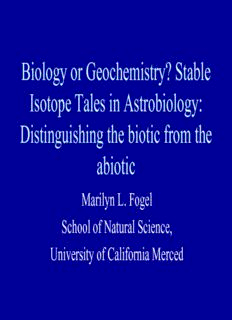
Distinguishing biotic from abiotic carbon on earth and other planets PDF
Preview Distinguishing biotic from abiotic carbon on earth and other planets
Biology or Geochemistry? Stable Isotope Tales in Astrobiology: Distinguishing the biotic from the abiotic Marilyn L. Fogel School of Natural Science, University of California Merced Biogeochemist or Geobiologist: Stable Isotope Geochemistry & Ecology • Study modern ecosystems-learn how they function • From modern ecosystems-figure out how organisms lived on Earth for 4 Billion years • Knowing life on Earth- study meteorites etc. to search for evidence of life in the Universe. Bringing the Search for Life Down to Earth AMASE: Arctic Mars Analogue Svalbard Expedition Life in Rocks How can we recognize it? Stable Isotope Measurements: 1 millimeter in a Kilometer 12C 98.89% 14N 99.7% 13C 1.11% 15N 0.3% Isotopic Composition (δ) δ13C (‰) = [13C/12C sample/ 13C/12C standard -1] *1000 Carbon isotopes (δ13C) of Plants = Photosynthesis (Biology) C-3 Photosynthesis evolved 1st C-4 Photosynthesis: few million years old Rubisco is the Key Enzyme causing the carbon isotope fractionation during photosynthesis: Molecular Weight of 550,000 Daltons Guy, Fogel, and Berry, 1993
Description: